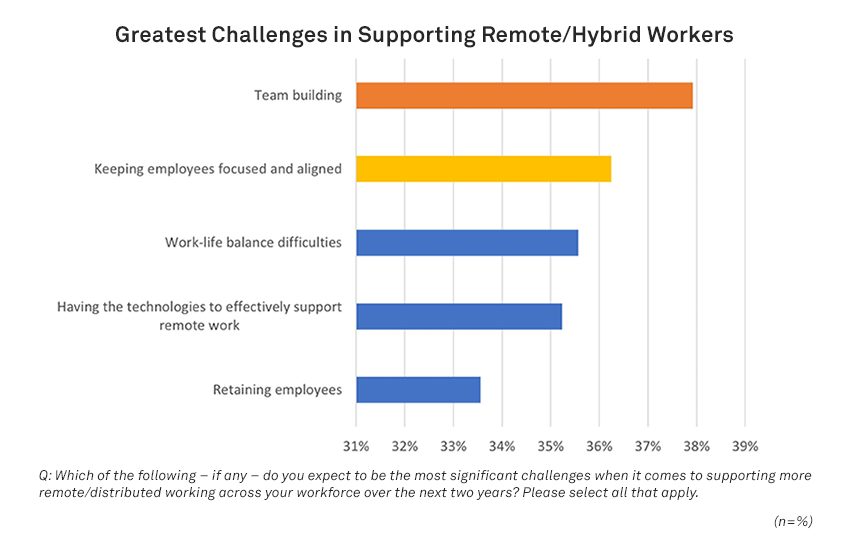
In part one of our two-part series, we look at invasive employee productivity tracking, often known as “bossware.” In many industries, the permanent shift to remote and hybrid work models is a foregone conclusion, but the friction associated with this change will be longstanding. In fact, according to data from 451 Research’s Technology Ecosystems 2022 survey, nearly 60% of businesses expect to deal with at least some challenges in supporting a more distributed workforce over the next two years.
As teams become more distributed, managers begin to lose the direct visibility associated with physical workplaces, and some organizations have turned to monitoring software installed on endpoints to track employee productivity. The most nefarious can monitor employee screens, track mouse movements and even spy on workers directly through the webcam. Despite the obvious privacy implications, so-called bossware represents a disconnect between the old ways of managing — watching screens — and the evolving reality of remote work. Data and productivity analytics tools have the potential to be powerful, but they can be counterproductive if they aren’t used in the right context.
The Take
The rapid shift to widespread remote and flexible work models, especially during the pandemic, gave many organizations a sudden and visceral sense of loss of control. How can businesses know employees are really doing their job if a manager can’t observe workers in a physical office? Employee productivity tracking software, colloquially known in its more invasive form as bossware, has gained enterprise interest to assuage the fear, uncertainty and doubt felt by management as knowledge workers transition to more flexible hours and home-based work environments — often measuring activities that were associated with productivity in brick-and-mortar environments. While worker productivity remains a valuable goal for every organization, problems arise when organizations conflate invasive tracking metrics with meaningful results and long-term business outcomes.
Context
Increasingly granular tracking of online worker behavior comes with an array of potential complications related to employee privacy rights, unintended behavioral consequences and the false business confidence imbued by metrics that may not represent the right elements of work efficacy. This isn’t to say that productivity tracking is inherently bad; it just needs to adapt to the realities of modern work and be fully understood as a single variable in a complex productivity equation. Most importantly, in the new flex/remote work era, businesses must shift their objectives toward measuring ultimate business outcomes and project success if they are to fully understand employee contributions and maximize employee engagement.
How did we get here?
To understand the rise of bossware, it is important to detail converging priorities across the organization. As the figure below shows, the top two challenges in supporting remote workers as identified in our Technology Ecosystems survey were team building (38%) and keeping employees focused and aligned (36%). It is the latter where many managers believe bossware may help them. If managers can’t peek over their remote workers’ shoulders to keep them on task, they want a tool that will do it for them. Herein lies the grand disconnect between the new reality of remote work and the legacy of in-office management.

Beyond this, however, bossware can be positioned in a way that ticks a box for IT too. When asked about the IT-led priorities in digital transformation, the top goal in our survey, at 44%, was “improve the workforce productivity and engagement experience.” If an organization erroneously associates productivity with time spent in an application, or how much a mouse moves, bossware brings a metric that can hypothetically be useful for IT.
There is also HR, which began experimenting with tracking employees as part of the growing trend of people analytics before the pandemic, creating a perfect storm for something like bossware to take off. At the start of the pandemic, human resources was looked to as a leader in the elements of change management associated with the workforce shifts of 2020 and beyond. As such, it needed to affirm its value and bring more visibility to the forefront. In our Employee Lifecycle & HR 2022 survey, HR respondents listed visibility of the entire workforce as the top missing feature for their workforce management software. This is where bossware could have gotten its hold in HR.
There is a deep connection between employee productivity, employee engagement and employee retention — and that may be a deeper reason why managers, HR and IT have rolled out bossware. For many companies, though, it is the wrong approach, and creates a litany of issues in data governance, privacy and beyond.
Are we measuring the right things?
There’s a cliché management philosophy in the service industry: “If you can lean, you can clean.” When an employee is on the clock for a specific pre-determined amount of time in a physical space, the business has little tolerance for perceived idleness when energy could be channeled toward other useful tasks. However, with the rise of virtual and flexible work arrangements, trivial measurements of “busy work” may not be particularly helpful. Virtual work environments have largely dissolved the boundaries between personal and work time for many individuals, making the concept of tracking activity during a theoretical “on the clock” window arguably meaningless in a flexible work model.
One of the fundamental premises of bossware is that it helps measure and quantify activities that were associated with productivity in a physical workplace, which is also one of its biggest potential pitfalls for the organizations that adopt it. Time away from a physical desk in an office was (perhaps erroneously) often associated with a loss of productivity. In this sense, bossware in the virtual world has sought to quantify granular online activity on the worker’s endpoint, often a laptop, or other company device.
In seeking to quantify this online activity, many organizations may simply be avoiding quantifying the much more difficult determinant of success: the ultimate business outcomes associated with an employee’s efforts. With bossware, screen time and rote online activity has become a highly questionable proxy for the ultimate success of the projects and initiatives that an individual worker was contributing to. Rather than trying to quantify material business outcomes, many organizations are grasping to quantify the indirect metrics they think contribute to those outcomes. In the virtual and hybrid world, they could be measuring the wrong things.
Granular employee activity monitoring is no replacement for measuring the success of long-term business outcomes in a virtual model. Until organizations refine their methods for quantification of these long-term business outcomes, invasive bossware will likely retain its appeal. Trouble is on the horizon, however. Bossware aims to make the business more data-driven in its management of talent; yet privacy is a key barrier for many organizations that are attempting to become more data-driven. Based on 451 Research’s Data-Driven Practices 2022 survey, 28.3% of respondents report that “data privacy” is one of the most significant barriers to becoming more data-driven as an organization.
Consumers and employees alike are gradually gaining additional data privacy rights in many jurisdictions around the globe. For organizations that extensively utilize bossware in a virtual environment, this may result in complications (which we will discuss in part two of this report).
Want insights on workforce productivity and collaboration trends delivered to your inbox? Join the 451 Alliance.
